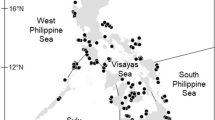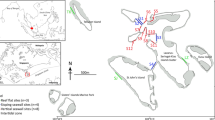Abstract
The interstices of coral rubble, the most common deposits of many reefs, provide extensive surfaces for a variety of sessile and vagile coelobites (cavity-dwellers). In the northern Florida Reef Tract there are at least 80 different sessile coelobites in coral rubble collected from 21 stations from in-shore lagoon to fore-reef, depth 40 meters. Three microzones of coelobites on the undersides of rubble were distinguished on the bases of their dominant community assemblages; algal microzone in the peripheral area, sponge-bryozoan microzone in the transitional area, and foraminiferal microzone in the central area. In the transect that extends some 6–7 km across the reef tract, the biomass is largest in the rubble of the shallow (1–3 m) shelf margin and it decreases shoreward and in deeper water; however, the maximum variety of species comes in the fore-reef at depths of about 20–30 m. Four coelobite zones are recognized in the reef transect based on distribution pattern and relative abundance of diagnostic species; 1) in-shore lagoon zone, 2) lagoon-reef zone, 3) marginal reef zone, and 4) fore-reef zone. Although this paper does not propose a comprehensive explanation for the distribution of coelobites, it does emphasize the importance of two factors that affect coelobite development and distribution: interstitial sediment as a negative (limiting) factor and flushing as a positive factor.
Similar content being viewed by others
References
Buss LW, Jackson JBC (1979) Competitive networks: non-transitive competitive relationships in cryptic coral reef environments. Am Nat 113:223–234
Cinelli R, Fresi E, Pansini M, Pronzato R, Svoboda A (1977) Distribution of benthic phyto- and zoocoenoses along a light gradient in a superficial marine cave. In: Keegan BF, Ceidigh PO, Boaden PJS (eds) Biology of benthic organisms. Proc 11th Eur Mar Biol Symp, Ireland, Galaway, pp 173–183
Enos P (1977) Holocene sediment accumulations of the south Florida shelf margin. In: Enos P, Perkins RD (eds) Quaternary sedimentation in south Florida. Geol Soc Am Mem 147:1–130
Garrett P (1969) The geology and biology of large cavities in Bermuda reefs. Bermuda Biol Stn Spec Publ 2:77–88
Garrett P, Smith DL, Wilson AO, Patriquin D (1971) Physiography, ecology, and sediments of two Bermuda patch reefs. J Geol 79:647–668
Ginsburg RN (1956) Environmental relationship of grain size and constituent particles in some South Florida carbonate sediments. Am Assoc Petrol Geol Bull 40:2384–2427
Ginsburg RN, Schroeder JH (1973) Growth and submarine fossilization of algal cup reefs, Bermuda. Sedimentology 20:575–614
Hutchings PA (1981) Polychaete recruitment onto dead coral substrates at Lizard Island, Great Barrier Reef, Australia. Bull Mar Sci 31:410–423
Hutchings PA, Weate PD (1977) Distribution and abundance of cryptic fauna from Lizard Island, Great Barrier Reef. Mar Res Indonesia 17:99–112
Jackson JBC (1977a) Habitat area, colonization, and development of epibenthic community structure. In: Keegan BF, Ceidigh PO, Boaden PJS (eds) Biology of benthic organisms. Pergamon Press, Oxford, pp 349–358
Jackson JBC (1977b) Competition of marine hard substrata: the adaptive significance of solitary and colonial strategies. Am Nat 111:743–767
Jackson JBC (1979) Overgrowth competition between encrusting cheilostome ectoprocts in a Jamaican cryptic reef environment. J Anim Ecol 48:805–823
Jackson JBC, Goreau TF, Hartman WD (1971) Recent brachiopodcoralline sponge communities and their paleoecological significance. Science 173:623–625
Jackson JBC, Palumbi SR (1979) Regeneration and partial predation in cryptic coral reef environment: preliminary experiments on sponges and ectoprocts. Colloq Int CNRS 291:303–308
Jackson JBC, Winston JE (1982) Ecology of cryptic coral reef communities. I. Distribution and abundane of major groups of encrusting organisms. J Exp Mar Biol Ecol 57:135–147
Laborel J, Vacelet J (1958) Etude des peuplements d'une grotte sousmarine de la region de Marseille. Bull Inst Oceanogr Monaco 1120:1–20
Logan A (1975) Geological observations on the recent articulate brachiopod Argyrotheca bermudana Dall from Bermuda platform. Bull Mar Sci 25:186–204
Logan A (1977) Reef-dwelling articulate brachiopods from Grand Cayman, B.W.I. Proc 3rd Int Coral Reef Symp 1:88–93
Logan A (1981) Sessile invertebrate coelobite communities from shallow reef tunnels, Grand Cayman, B. W. I. Proc 4th Int Coral Reef Symp 2:735–744
Lowenstam HA (1968) Adaptive traits in skeletal morphology. In: Paleoecology Am Geol Inst Short Course Lecture Notes, pp HL-1–HL-12
Palumbi SR, Jackson JBC (1982) Ecology of cryptic coral reef communities. II. Recovery from small disturbance events by encrusting bryozoa: the influence of “host” species and lesion size. J Exp Mar Biol Ecol 64:103–115
Pouliquen L (1969) Remarques sur la présence d'Esponges de l'étage bathyal dans les grottes sous-marines obscures de Méditerranée. CR Acad Sci Paris 268:1324–1326
Reiswig HM (1973) Population dynamics of three Jamaican Demospongiae. Bull Mar Sci 23:191–226
Rooney WS (1970) A preliminary ecologic and environmental study of the sessile foraminifer Homotrema rubrum (Lamarck). Bermuda Biol Stn Spec Publ 6:7–18
Schroeder JH, Zankl H (1974) Dynamics reef formation: a sedimentological concept based on studies of recent Bermuda and Bahama reefs. Proc 2nd Int Coral Reef Symp 2:413–428
Scoffin TP, Garrett P (1974) Processes in the formation and preservation of internal structure in Bermuda patch reefs. Proc 2nd Int Coral Reef Symp 2:429–448
Sollas WJ (1905) The age of the earth and other geological studies. Fisher Unwin, London
Vacelet J (1967a) Description d' Eponges Pharetronides actuelles des tunnels obscurs sous-récifaux de Tuléar (Madagascar). Rec Trav Stn Mar Endoume-Marseille Fasc Hors Sér Suppl 6:37–62
Vacelet J (1967b) Quelques Eponges Pharetronides et “Silico-calcaires” des grottes sous-marines obscures. Rec Trav Stn Mar Endoume-Marseille Fasc Hors Sér Suppl 58:121–132
Vacelet J (1976) Les spongiaires des grottes sous-marines obscures de la Mediterranée et des régions tropicales. Pubbl Stn Zool Napoli 40:506–515
Vacelet J, Vasseur P (1965) Spongiaires des grottes et surplombs des récifs de Tuléar (Madagascar). Rec Trav Stn Mar Endoume-Marseille Fasc Hors Sér Suppl 4:71–123
Vacelet J Vasseur P (1966) Les tunnels obscurs sous-récifaux de Tuléar (Madagascar) et faune de spongiaires 2nd Int Ocean Congr Moscow 1966:378
Vasseur P (1964) Contribution à l'étude bionomique des peuplements sciaphiles infralitoraux de substrat dur dans les récifs de Tuléar (Madagascar). Rec Trav Stn Mar Endoume-Marseille Fasc Hors Ser Suppl 2:1–77
Vasseur P (1974) The overhangs, tunnels and dark reef galleries of Tulear (Madagascar) and their sessile invertebrate communities. Proc 2nd Int Coral Reef Symp 2:143–159
Vasseur P (1977) Cryptic sessile communities in various coral formations on reef flats in the vicinity of Tuléar (Madagascar), Proc 3rd Int Coral Reef Symp 1:95–100
Warme JE (1977) Carbonate borets-their role in reef ecology and preservation. Am Assoc Petrol Geol 4:261–279
Zankl H, Schroeder JH (1972) Interaction of genetic process in Holocene reefs off North Eleuthera Island, Bahamas. Geol Rundsch 61520–541
Zibrowius H (1978) Les scléractiniaires des grottes sous-marines en Méditerranée et dans l'Atlantique nord-oriental (Portugal, Madére, Canaries, Açores). Pubbl Stn Zool Napoli 40:516–545
Author information
Authors and Affiliations
Rights and permissions
About this article
Cite this article
Choi, D.R., Ginsburg, R.N. Distribution of coelobites (cavity-dwellers) in coral rubble across the Florida Reef Tract. Coral Reefs 2, 165–172 (1983). https://doi.org/10.1007/BF00336723
Received:
Accepted:
Issue Date:
DOI: https://doi.org/10.1007/BF00336723




